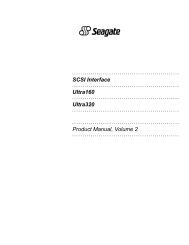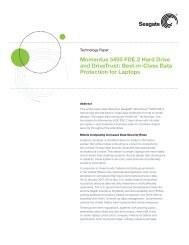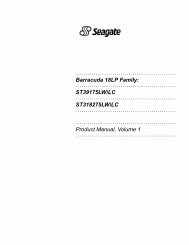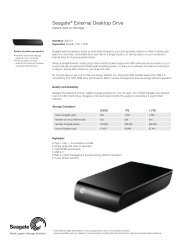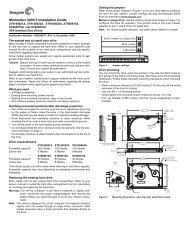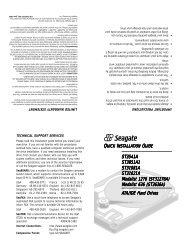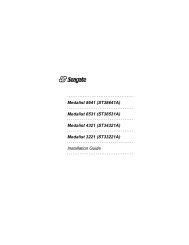Quickview 300 Product Manual PATA - Seagate
Quickview 300 Product Manual PATA - Seagate
Quickview 300 Product Manual PATA - Seagate
Create successful ePaper yourself
Turn your PDF publications into a flip-book with our unique Google optimized e-Paper software.
Glossary<br />
DISK CONTROLLER – A plug-in board,<br />
or embedded circuitry on the drive, that<br />
passes information to and from the disk. The<br />
Maxtor disk drives all have controllers<br />
embedded on the drive printed-circuit board.<br />
DISKWARE – The program instructions<br />
and data stored on the disk for use by a<br />
processor.<br />
DMA – Acronym for direct memory access. A<br />
process by which data moves directly between<br />
a disk drive (or other device) and system<br />
memory without passing through the CPU,<br />
thus allowing the system to continue<br />
processing other tasks while the new data is<br />
being retrieved.<br />
DRIVE – Short form of disk drive.<br />
DRIVE GEOMETRY – The functional<br />
dimensions of a drive in terms of the number<br />
of heads, cylinders, and sectors per track. See<br />
also logical format.<br />
E<br />
ECC – Acronym for error correction code. The<br />
recording of extra verifying information<br />
encoded along with the disk data. The<br />
controller uses the extra information to check<br />
for data errors, and corrects the errors when<br />
possible.<br />
EMBEDDED SERVO – A timing or<br />
location signal placed on the disk’s surface on<br />
the tracks that also store data. These signals<br />
allow the actuator to fine-tune the position of<br />
the read/write heads.<br />
ENCODING – The protocol by which<br />
particular data patterns are changed prior to<br />
being written on the disk surface as a pattern<br />
of On and Off or 1 and 0 signals.<br />
EXTERNAL DRIVE – A drive mounted in<br />
an enclosure separate from the PC or<br />
computer system enclosure, with its own<br />
power supply and fan, and connected to the<br />
system by a cable.<br />
F<br />
FAT – Acronym for file allocation table. A data<br />
table stored on the outer edge of a disk that<br />
tells the operating system which sectors are<br />
allocated to each file and in what order.<br />
FCI – Acronym for flux changes per inch. See<br />
also BPI.<br />
FILE SERVER – A computer that provides<br />
network stations with controlled access to<br />
shareable resources. The network operating<br />
system is loaded on the file server, and most<br />
shareable devices (disk subsystems, printers)<br />
are attached to it. The file server controls<br />
system security and monitors<br />
station-to-station communications. A<br />
dedicated file server can be used only as a file<br />
server while it is on the network. A non<br />
dedicated file server can be used<br />
simultaneously as a file server and a<br />
workstation.<br />
FLUX DENSITY – The number of<br />
magnetic field patterns that can be stored in a<br />
given length of disk surface. The number is<br />
usually stated as flux changes per inch (FCI),<br />
with typical values in the thousands.<br />
FLYING HEIGHT – The distance between<br />
the read/write head and the disk surface<br />
caused by a cushion of air that keeps the head<br />
from contacting the media. Smaller flying<br />
heights permit more dense storage of data, but<br />
require more precise mechanical designs.<br />
FORMAT – To write onto the disk surface a<br />
magnetic track pattern that specifies the<br />
locations of the tracks and sectors. This<br />
information must exist on a disk before it can<br />
store any user data. Formatting erases any<br />
previously stored data.<br />
FORMATTED CAPACITY – The<br />
amount of room left to store data on the disk<br />
after the required space has been used to write<br />
sector headers, boundary definitions, and<br />
timing information generated by a format<br />
operation. All Maxtor drive capacities are<br />
expressed in formatted capacity.<br />
FORM FACTOR – The physical outer<br />
dimensions of a device as defined by industry<br />
standard. For example, most Maxtor disk<br />
drives use a 3 1/2-inch form factor.<br />
<strong>Quickview</strong> <strong>300</strong> 80/100/120/160/200/250/<strong>300</strong>GB <strong>PATA</strong> G-3



